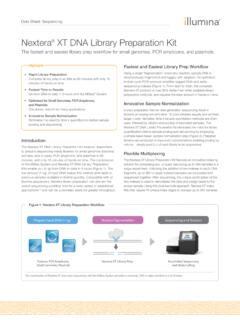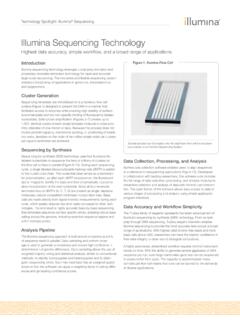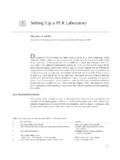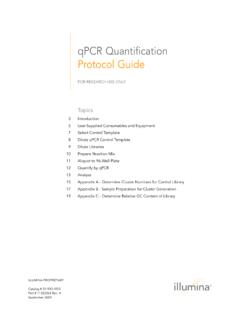Transcription of 16S Metagenomics Studies with the MiSeq System
1 Application Note: Microbial GenomicsIntroductionMetagenomic surveys of microbial populations are often performed using the prokaryotic 16S ribosomal RNA (rRNA) gene, which contains conserved and variable regions that facilitate sequencing and phylogenetic classification. Following the complete Illumina workflow (Figure 1), 16S Metagenomics Studies with the MiSeq System can achieve species-level identification of microbial populations efficiently. The workflow includes DNA isolation, library preparation, sequencing , and push-button analysis, delivering an end-to-end solution for 16S Metagenomics .
2 By combining the demonstrated Illumina library preparation protocol, the MiSeq System , and simple analysis software, researchers can analyze complex microbial samples quickly and easily. This application note provides an overview of the Illumina 16S Metagenomics workflow and the results of a study that examined microbial populations in a water reservoir. This study was conducted in collaboration with the Center for Earth and Environmental Science at Indiana University Purdue University Indianapolis (IUPUI) and Citizens Energy Group. The results reveal patterns in the reservoir s microbial community that can potentially be used to assess environmental influences on water study used the 16S Metagenomic sequencing Library Preparation Guide1 to prepare sequencing libraries targeting the variable V3 and V4 regions of the 16S rRNA gene.
3 Paired-end sequencing was performed on the MiSeq System and data were analyzed using the 16S Metagenomics App in the BaseSpace analysis environment. Sample CollectionWater samples were collected from the Eagle Creek reservoir in Indianapolis, Indiana at regular intervals throughout one year. Discrete samples were collected from the surface and at depths of 3 meters, 6 meters, and near the bottom floor of the IsolationEpicentre DNA isolation kits deliver high-quality, inhibitor-free DNA from mixed samples of gram-positive and gram-negative bacteria derived from many environmental sources, including water, soil, fecal matter, and compost (Table 1).
4 In this study, DNA was isolated from 27 water samples using the Meta-G-NomeTM DNA Isolation Kit2. Approximately 700 ng of DNA were extracted from each Metagenomics Studies with the MiSeq SystemFrom DNA isolation to analysis, this simple workflow enables species-level identification of complex microbial populations in 2 days. Figure 1: Multiplexed 16S Amplicon sequencing WorkflowFrom DNA isolation to push-button analysis, the Illumina 16S Metagenomics workflow provides a complete solution for complex community analyses. sequencing with the MiSeq System delivers highly accurate data, and analysis includes classification using BaseSpace or MiSeq Reporter 1.
5 DNA Isolation KitsSample TypeIsolation KitWaterMetagenomic DNA Isolation Kit for Water3 SoilSoilMasterTM DNA Extraction Kit4 Fecal matterExtractMasterTM Fecal DNA Extraction Kit5 Difficult-to-culture species present in environmental water, soil, or compostMeta-G-Nome DNA Isolation KitEpicentre DNA isolation kits are optimized to isolate bacterial DNA obtained from various BacteriaGammaproteobacteriaBetaproteobac teriaProteobacteriaBacteroidetesSphingob acteriiaSphingobacterialesDesign and order region of interest-speci c primers with overhang Probe 1 Custom Probe 2 Generate template libraries and attach indexes and sequencing adapters by data using the Metagenomics 16S rRNA Work ow in MiSeq Reporter software or the 16S Metagenomics App in automated cluster generation and sequencing on the MiSeq Note.
6 Microbial GenomicsLibrary PreparationThe Illumina 16S Metagenomic sequencing Library Preparation Guide is an easy-to-follow protocol for preparing DNA libraries. It is optimized to target the V3 and V4 regions of the 16S rRNA gene, although it can be adapted to target other variable regions. The 16S Metagenomic sequencing Library Preparation Guide leads users through each step of library preparation, from genomic dna to sequencing -ready libraries. All necessary reagents are listed, including the required primer sequences that target the V3 and V4 regions of the 16S rRNA gene. These primers can also be modified to target different regions of the 16S gene, or altered for custom applications.
7 The 27 samples from the reservoir were prepared using the 16S library preparation protocol and the Nextera XT DNA Index Kit6 for cost-effective sample multiplexing. SequencingThe MiSeq System can deliver 2 300 bp reads and up to 50 million paired-end reads, generating up to 15 Gb of data. The flexible System enables microbiologists to scale Studies from one to hundreds of samples. Micro and nano flow cell options and accompanying reagents are available to support lower-throughput experiments by optimizing sample volume and coverage needs (Table 2).Samples from the reservoir were loaded onto a MiSeq reagent cartridge and then onto the instrument.
8 Automated cluster generation and a 2 300 bp paired-end sequencing run were performed. The resulting sequence reads were equally distributed across the samples, demonstrating uniform AnalysisIllumina has removed much of the complexity from sequencing data analysis. Following the Illumina workflow, researchers can analyze sequencing data generated on the MiSeq System either on the instrument or in BaseSpace. MiSeq Reporter software is able to analyze data on the sequencer or on a standalone computer. Alternatively, data can be transferred, analyzed, stored, and shared with collaborators in BaseSpace.
9 BaseSpace can deliver analyzed sequences in as little as 12 hours following the 16S workflow, and BaseSpace applications (apps) provide access to a growing collection of analysis reservoir samples were analyzed using the BaseSpace 16S Metagenomics App (Figure 2). The app delivers all phylogenetic data including coverage statistics and detected species in intuitive, easy-to-analyze reports. sequencing reads are classified against the Greengenes7 database, achieving up to species-level 16S Metagenomics App delivers highly interactive visualizations for exploring taxonomic classifications.
10 The sunburst classification chart provides a detailed view of the relative abundance of bacterial species within each taxonomic level. Researchers can select a category to magnify a particular level of interest and explore the diversity of any sample (Figure 3). Figure 2: 16S Metagenomics AppThe 16S Metagenomics App features an intuitive user interface to simplify analysis of environmental samples. Figure 3: Relative Abundance by Taxonomic LevelThe interactive sunburst chart in the BaseSpace 16S Metagenomics App shows the relative abundance of bacterial species. Users can select any classification to magnify a taxonomic level of interest.












